Mine Action in Afghanistan and Tajikistan: Challenges and Opportunities
By Markus Schindler [ Swiss Foundation for Mine Action ]
CISR JournalThis article is brought to you by the Center for International Stabilization and Recovery (CISR) from issue 25.3 of The Journal of Conventional Weapons Destruction available on the JMU Scholarly Commons and Issuu.com.
Rugged mountains, challenging road conditions, ongoing security concerns, and a fluctuating donor landscape present a wide range of obstacles to mine clearance efforts in Afghanistan and neighboring Tajikistan. The Swiss Foundation for Mine Action (FSD) first entered the region in 2001 in the wake of the US-led invasion of Afghanistan. Since then, the mine action sectors in both countries have seen significant progress and growth. FSD has been part of this process since its early days through its country programs in Tajikistan and Afghanistan, engaging in a variety of mine action activities including clearance (manual, mechanical, and with mine detection dogs [MDD]), risk education, stockpile destruction, and victim assistance. This article describes the contexts of both countries’ contamination and the ways in which mine action has been applied to mitigate the impact of explosive ordnance (EO). The article also explores the obstacles and challenges that mine action organizations face in Afghanistan and Tajikistan, respectively, and describes how they can be overcome.
Afghanistan and Tajikistan share as many commonalities as they are divided by differences. The countries’ histories are intertwined yet unfolded along very different lines. The territories of both countries were contaminated with mines during the Soviet-Afghan War in the 1980s, and both countries experienced subsequent civil wars during the 1990s that added to the contamination. Yet while Tajikistan found relative stability by the end of the 1990s, Afghanistan continued to be engulfed in seemingly endless wars and presently looks ahead to an uncertain future.
FSD began working in Afghanistan in 2001. Ten mine action emergency response teams and a planning and coordination unit were deployed and integrated into the World Food Programme’s (WFP) special operation for Afghanistan. During this time, FSD also began with the assessment of Tajikistan’s EO contamination, and in 2003 signed an agreement with the Organization for Security and Co-operation in Europe (OSCE) for the first
internationally-supported mine action program in Tajikistan.
Tajikistan
Tajikistan is a landlocked country in Central Asia. Mountains cover 93 percent of its territory,1 and about half of the country is over 3,000 meters (9,800 ft) above sea level, lending particular significance to the flat and arable areas in its southwest and north. Over 72 percent of Tajikistan’s population live in rural districts,2 and farming is a key economic factor in one of Central Asia’s poorest countries. Gaining independence after the dissolution of the Soviet Union, Tajikistan went through a decade of upheaval during the 1990s. Three conflicts occurred during this time that left the country contaminated with mines and other types of EO:
- Between 1992 and 1998, the Russian army laid mines along Tajikistan’s southern border with Afghanistan.3
- Between 1992 and 1997, Tajikistan suffered the most severe civil war among the conflicts that erupted throughout the former Soviet Union after it collapsed in 1990/1991.4 Landmines were used throughout the civil war, especially in central Tajikistan; moreover, the five-year conflict left the country contaminated with unexploded ordnance (UXO).
- Between 1999 and 2001, areas along Tajikistan’s borders to the east and north were mined during conflicts with neighboring Uzbekistan and Kyrgyzstan.5
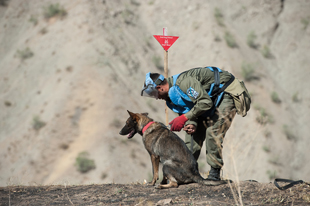
MDD team clearing hazardous areas in Tajikistan. All images courtesy of the author/FSD.
Sections of the borders as well as many minefields between Tajikistan and its neighboring countries are not yet fully defined6 and marked, putting the civilian population at a high risk. Mine accidents have taken a heavy toll among civilians and livestock. However, many accidents still go unreported due to the extreme isolation of the affected regions and the lack of medical facilities.
Tajikistan is one of the 164 parties to the Anti-Personnel Mine Ban Treaty7 and in 2003 formed the Tajik National Mine Action Center (TNMAC) to oversee the implementation of the country’s treaty obligations. FSD began operations in Tajikistan the same year in support of the national authorities, conducting technical surveys (TS) and mine clearance operations. Since its inception, the program has undergone major transformations and has accomplished important advancements towards the ultimate goal of establishing sustainable, nationalized mine action capabilities for Tajikistan. After nineteen years of continuous operations, the Tajikistan program is FSD’s longest-running country program.
Since its first mission to Tajikistan, FSD has conducted assessments and surveys in order to provide a clear picture of the country’s contamination and to prepare its clearance operations. This includes TS, non-technical survey (NTS), as well as socioeconomic baseline and impact surveys. In its Tajikistan program, FSD has deployed all standard land release/demining methodologies and assets in common practice: manual demining teams, MDD teams, mechanical demining teams, and survey/explosive ordnance risk education (EORE) teams. In recent years, FSD’s focus has shifted to supporting the Tajik authorities in safely destroying poorly stored surplus weapons and ammunition (WAD), including Man Portable Air Defense Systems (MANPADS).8
FSD’s early demining operations were primarily located in Tajikistan’s western, mountainous Gorno-Badakhshan region, as well as in its southern, agricultural Kathlon region. Until 2010, FSD deployed its survey, manual clearance, and MDD teams primarily in areas contaminated during the 1992–1997 civil war. These areas were often mountainous and difficult to access and operate in, and affected by severe weather that resulted in relatively short demining seasons. FSD has therefore put particular emphasis on recruiting deminers locally to support affected communities but also to benefit from local knowledge and increased access. Good relations with local authorities have proven vital, as has the deployment of vehicles and equipment suitable for the harsh terrain.
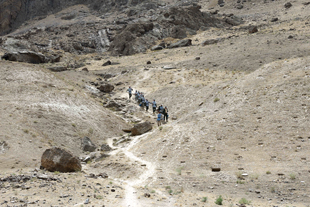
FSD manual clearance team descending from a hazardous area in Badakhshan, Afghanistan.
By 2010, FSD had cleared most of the areas contaminated during the Tajik civil war and shifted its focus to the clearance of mine belts laid by former Soviet forces on the Tajik side of the Tajikistan-Afghanistan border. These areas, particularly those in the heavily mined western part of the border along the Amu Darya river, contaminate parts of Tajikistan’s scarce, flat, and fertile land. For this reason, FSD deployed two mechanical demining teams, each equipped with a remote controlled MV4 mini flail. Also in 2010, Norwegian People’s Aid (NPA) joined FSD and became the second humanitarian mine action (HMA) program in Tajikistan.
Unfortunately, funding levels for humanitarian demining started to decline in the mid-2010s, and in 2018 FSD was forced to cease demining operations in Tajikistan. This further impacted an already underfunded mine action sector in Tajikistan, and contributed to the need for Tajikistan to request an additional extension on their Mine Ban Treaty obligations under Article 5.
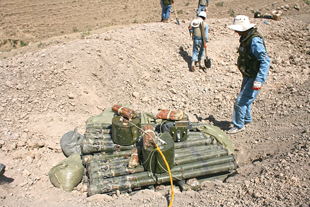
Demolition of MANPADS from military stockpile, Tajikistan, 2011.
At the close, FSD had released more than 38 million square meters of land—over 11 million square meters cleared and over 27 million square meters of suspected contaminated areas cancelled through survey. However, FSD continues WAD operations in Tajikistan. Moreover, FSD has also developed a number of environmental remediation projects, socioeconomic and sociomedical interventions, and capacity-building projects in Tajikistan and neighboring Kyrgyzstan.
Afghanistan
More than for its rugged terrain and its cultural and linguistic diversity, Afghanistan is best known for its tragic contemporary history. Invasions and civil wars have held the country in their grip for the past four decades and turned Afghanistan into one of the countries most contaminated by mines and explosive remnants of war (ERW).
Much of the country’s explosive contamination originated during the Soviet-Afghan War, throughout which large areas of the countryside and border regions were mined. Afghanistan’s civil war following the Soviet retreat added further contamination, and the violent struggle against the US-led coalition and the Afghan government saw an increased use of improvised explosive devices (IEDs).
FSD initially deployed to Afghanistan in the wake of the US-led invasion in 2001, setting up quick-reaction teams in the major population centers to provide mine action assistance for the WFP’s distribution to the civilian population. FSD’s tasks included EORE for the staff of WFP and other humanitarian organizations; inspecting and demining of WFP infrastructures such as storage units, distribution sites, offices, and staff housing; marking and mapping of hazard areas; training local mine action organizations in techniques for treating and neutralizing weapons and EO; and destroying stocks of landmines and ammunition. The Mine Action Emergency Response program was completed in early 2003, and equipment was formally handed over to the Mine Action Program for Afghanistan. Throughout the program, FSD teams have destroyed more than 143,000 items of UXO.9
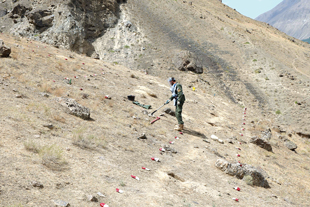
Mine clearance in northern Badakhshan, Afghanistan.
After a seven-year absence, FSD started the first regional cross-border land release project between Tajikistan and Afghanistan in a difficult to access area in Afghanistan’s Badakhshan Province in 2010. Covered in snow-capped mountains, the remote northern districts of Badakhshan are isolated from the rest of the country by the Hindu Kush mountain range. From a logistic point of view, it was much easier to access this remote province via a cross-border operation from Tajikistan to the north. FSD did so from an operational office in Kalai Khumb on the Tajik side of the Panj Valley.
As a border region with the Soviet Union, the northern parts of Badakhshan Province were heavily mined in order to hamper Mujahideen attacks on Soviet bases on both sides of the border. Soviet forces primarily laid PMN-2 anti-personnel (AP) mines as well as scatterable PFM-1 AP mines, which were often deployed from helicopters. These minefields continue to pose a severe threat to human life but also to cross-border economic, social, and cultural exchange.
Through lobbying efforts by FSD, the governments of Afghanistan and Tajikistan signed a landmark international agreement for cross-border cooperation on mine action activities. As a result, TNMAC rather than the Afghan Mine Action Authority provided quality management (QM) for FSD’s work in Badakhshan Province due to the area’s inaccessibility from the Afghan side. However, the border closure in 2021 as a result of the political changes in Afghanistan has brought an end to this arrangement.10
FSD’s work in Afghanistan covers key aspects of mine action; several demining teams conduct mine clearance and battle area clearance (BAC). Since 2011, FSD’s teams have cleared over 2.24 million square meters of minefields and nearly 440,000 square meters of former battlefields. In the process, they destroyed almost 32,000 AP mines and 12,400 UXO. FSD also deploys a number of teams that conduct NTS and EORE for affected populations. Moreover, since 2018, FSD has also taken advantage of its presence in local communities to interview and support survivors of mine accidents. Many of the survivors have already received medical care, but their daily lives are still heavily impacted by their disabilities, an additional factor of vulnerability in this poor and isolated region. From 2019 to 2020, FSD assessed the needs of around 100 survivors.
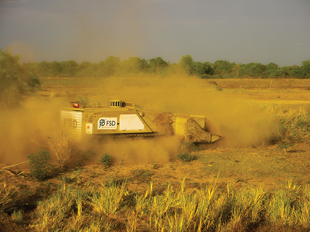
Mechanical clearance with MV4 mini flail, Tajikistan.
Notably, the effects of these disabilities extend beyond the physical. Due to their injuries and the lack of environmental adaptions available, many mine survivors are at risk to become effectively ostracized from the local community and find it difficult to contribute due to stigma and discrimination. This in turn compounds the burden of many of the survivors, who are often already struggling with the psychological trauma resulting from their injuries.
In order to address this, FSD is developing a number of assistance projects for mine survivors. The first of these efforts started in March 2020 with a small-scale facilitation project that aims to facilitate travel and accommodation for survivors who require support as identified during FSD’s interviews. Mine survivors are given assistance with transport and accommodation to enable their attendance at a specialist clinic run by the International Committee of the Red Cross (ICRC) in Faizabad. The ICRC assesses the survivors and, where needed, provides updated prosthetics or orthotics. This project has a minimal outlay in terms of capital and resources but can make a significant difference to the lives of survivors who could not otherwise afford the trip. FSD helped sixteen people from remote villages in Badakhshan Province to make the journey to Faizabad and receive support in 2021, and is expanding this effort in 2022 to other areas in northern Afghanistan.
This expansion will also aim to promote the socioeconomic reintegration of mine survivors and to enable them to better provide for their families once again. In doing so, the projects also seek to foster the psychosocial well-being of survivors. Projects include upgrading the accessibility and occupational health needs of survivors both in their own homes and in the wider community. Support provided could be as simple as providing a step-free access to areas or adapting furniture. Other projects will look to provide training and support to provide local employment for survivors. FSD will seek to ensure this effort is provided under a do-no-harm framework and as such is in the process of surveying the economies of local villages in Badakhshan Province.11 This will ensure that complementary and sustainable opportunities are created and balanced across the region.
Despite challenges, FSD remains operational in Afghanistan and has opened a new office in Kunduz. However, work in Afghanistan in the wake of the Taliban takeover has required adaption and careful assessment to ensure that staff can work safely. As discussed earlier in this article, in Tajikistan, one of the key facilitators for acceptance remains the relationships FSD has developed within local communities, especially with key gatekeepers such as village elders. Local Taliban leaders have had no objection to FSD continuing its work in Badakhshan but have requested that FSD coordinates and negotiates their plans with the local elders. FSD’s long involvement in Afghanistan and our proactive local staff have ensured that work can continue by maintaining these village level relationships, thus creating a permissive environment.
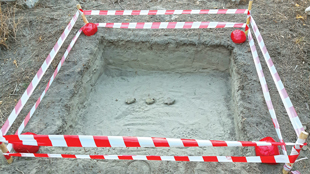
PFM1 AP mines found in Badakhshan, Afghanistan.
The challenges of operating in Afghanistan’s mountainous north are abundant. The ruggedness of the terrain and the poor road conditions result in slow movement. To reduce the risk of accidents and vehicle breakdowns, FSD deploys suitable four-wheel drive vehicles from regionally popular manufacturers to ensure the availability of spare parts. Moreover, many hazard areas in Badakhshan’s rugged north are located on steep slopes, while others are on valley floors and river banks. As a result, clearance rates can vary starkly between hazard areas. In addition, demining activities are suspended every year during the winter months until the snow melts. Deminers use this period to go home for some leave, to prepare their equipment, and to review demining procedures before the restart of operations in the new year.12
The security situation in northern Afghanistan has undergone numerous changes since FSD began operations there in 2011. Fighting between government and anti-government forces flared up regularly, and the control of areas shifted at times. Through constant monitoring, community engagement, and a high level of adaptability, FSD’s Afghanistan team was able to cope with these security challenges, save for a number of brief stand-downs. All teams are recruited locally, helping FSD staff to ensure close coordination and cordial relations with local authorities and community leaders. FSD’s teams in Afghanistan have continued this practice following the Taliban’s takeover of Afghanistan in 2021, affording the teams relative freedom of movement with no security incidents occurring.
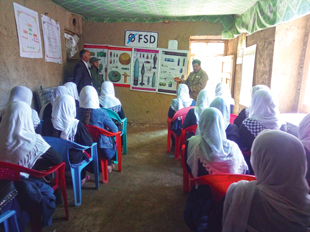
FSD EORE team leader conducts risk education at a girls’ school in Badakhshan, Afghanistan.
Cross-border projects bring a very particular set of challenges. Afghanistan’s border with Tajikistan is demarcated by rivers; crossing it was only possible via the few bridges that connect the two countries. However, the past two years have seen significant border closures. During the onset of the Coronavirus pandemic, the border was closed, and FSD’s Afghan teams were unable to receive demining equipment from its base in Tajikistan. Only lobbying and political intervention eventually brought a solution, when FSD staff based in Tajikistan was allowed to move vehicles and equipment from the regional headquarters (HQ) in Dushanbe and the operational HQ in Kalai Khumb to the border crossing at Jamarj-e Bala. A dozen vehicles with demining and hygiene equipment were transferred to the border crossing, where they were allowed to be driven onto the border bridge. The Tajik drivers then disinfected and left the vehicles and returned to Tajik soil, while FSD’s Afghan drivers walked onto the bridge from the other side to take over the vehicles and to drive them into Afghanistan.
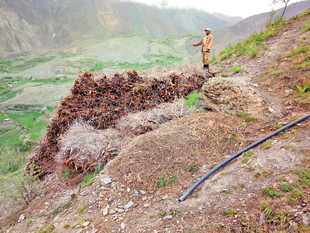
Another key challenge FSD experiences in Afghanistan’s remote north relates to gender, specifically the employment of women. Local culture prescribes strict gender roles, and the employment of women is often regarded as problematic. However, FSD was keen to ensure access to female mine survivors as part of the victim assistance project. To solve this problem, FSD hired four mixed teams, each consisting of a husband and wife. This way all teams were able to travel and access mine survivors regardless of their gender. Unfortunately, following last year’s political changes in Afghanistan, the local village elders asked FSD not to employ female staff and to cease the delivery of EORE to girls over the age of twelve. Whether this was a directive from the region’s new rulers, “preemptive obedience” on the part of the community leaders, or the local preference in accordance with the cultural norms in these remote areas is difficult to determine. While this is a regrettable development from FSD’s perspective, it is equally important to ensure the safety of all FSD staff in Afghanistan, including the safety of female staff.
As the political situation in Afghanistan has somewhat stabilized, FSD is eager to approach this matter again and to petition local authorities for permission to re-deploy female teams. However, the issue is very sensitive and, even if possible in principle, it may not yet be feasible in practice due to potential security risks for female staff.
Conclusion
Southern Central Asia is a region beset by many challenges. Natural obstacles such as the region’s rough terrain and harsh climate are compounded by various political issues and security concerns, particularly in Afghanistan. While suitable and well-maintained equipment is a crucial factor to success, the most important asset for any mine action organization operating in Afghanistan and Tajikistan is the trust and endorsement of local communities. A supportive population and eager local authorities are not only vital for access to potential hazard areas, affected people, and mine survivors, they’re also indispensable for the security of an organization’s staff. ◊
 Markus Schindler
Markus Schindler
Project Manager
Swiss Foundation for Mine Action
Markus Schindler is currently Project Manager for FSD in Iraq, where he oversees a capacity development project that aims to build the professional competence of a local mine action NGO. He has worked with FSD since 2014 with postings in the Philippines, Afghanistan, and Tajikistan. Schindler holds a master’s degree in strategic studies from University College Cork, a master’s degree in social science and ethics from Ruhr University Bochum, and a bachelor’s degree in philosophy from the University of Regensburg.

